My Favorite Hotels in Goa
• Vagator: W Goa
• Anjuna: Westin
• Calangute: Hard Rock Hotel
• Candolim: Taj Fort Aguada
• Panaji: Vivanta Goa
• Colva: Beleza by the Beach
• Benaulim: Taj Exotica
• Cavelossim: St Regis
• Agonda: Om Sai Beach Huts
• Palolem: Art Resort
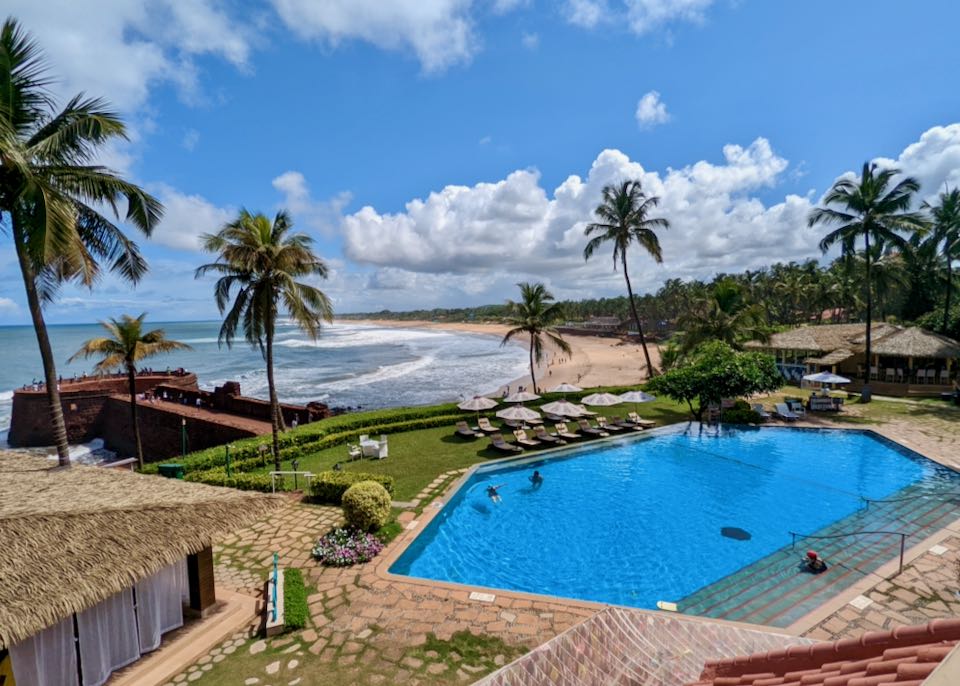
The Taj Fort Aguada in North Goa.
The Best Area to Stay in Goa
India’s smallest state has been the country’s prime tourist region since the Hippy Trail of the 1960s. As well as glorious beaches, inviting bars, and a laidback lifestyle to rival Bali and Thailand, Goa offers what is rarely (or ever) found elsewhere in India: manageable traffic and crowds, minimal pollution, spicy cuisine dominated by meat and seafood, water sports, loosely-regulated nightclubs, and very cheap alcohol. It also boasts a Portuguese colonial heritage of forts, food, and religion far more evident than the leftovers and legacies from the British Raj.
Goa more than doubles its population with tourists – mostly Indian, not foreign – and is busy and expensive during peak times (December and January), yet comparatively deserted during the monsoon (June to September). While most of the fifteen or so major beach regions have at least one of Goa’s best hotels, trendy boutiques, and/or chic yoga retreats, it’s still possible to find empty beaches and untouched fishing villages.
The 100km-long coastline is conveniently (but unofficially) separated into three areas: North Goa, which is more developed and has a party vibe; South Goa, which is more serene with empty yet accessible beaches; and Central Goa, dominated by the airport and capital, Panaji (Panjim). When deciding a base, also factor in distance from the airport (transfers of 1-2 hours are not uncommon) and the regional train and bus transport hubs of Panaji (for all of Goa), Margao (for the south), and Mapusa (for the north).
In South Goa, Majorda, and Betalbatim are comparatively close to the airport and linked by public bus to Margao. The roads are great for cycling and sections of these beaches are remarkably undeveloped. Farther down, Colva and Benaulim are dominated by midrange resorts, but meandering roads have hindered development and reduced traffic. Dotted with top-end resorts, Cavelossim offers an attractive beach and compact area of facilities, while nearby Mobor still has empty stretches of sand. Both areas are also alongside a river, have flat roads that are ideal for cycling, and are linked by public bus.
The regional capital and transport hub of Margao (Madgaon) has no beach but offers some colonial-era charm and decent facilities. To escape the overcrowding and high prices, head farther south to beaches at Cola/Khola (secluded because it’s not easy to reach), Agonda (more developed but with a village vibe and good surfing), Palolem (very scenic and popular for yoga/meditation), and Patnem (small, laidback, and packed with long-stayers).
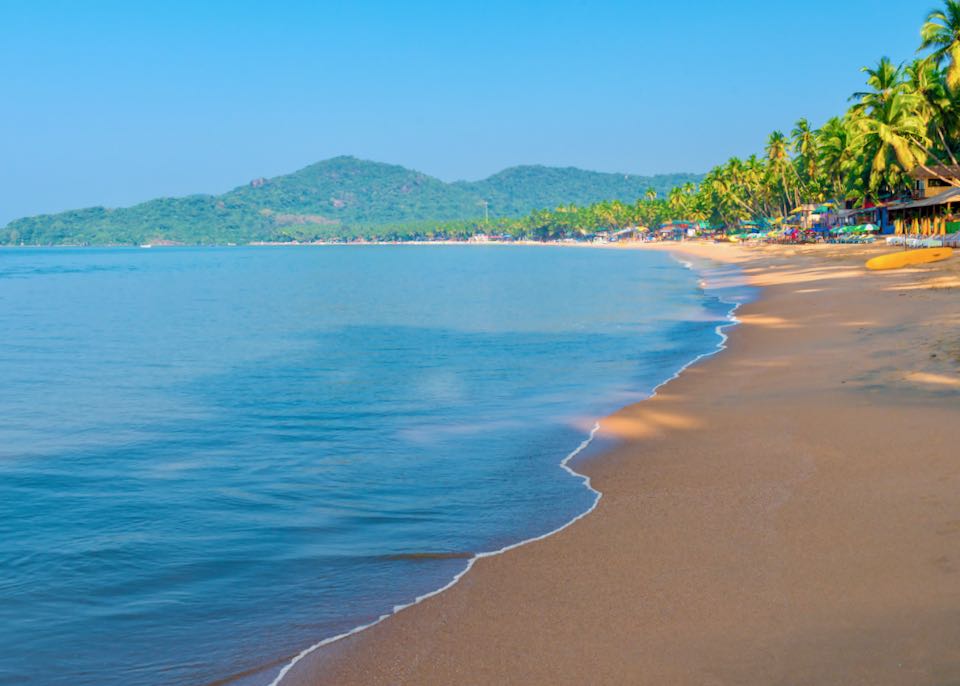
The idyllic beach in Palolem. Both the Hilias Retreat and Art Resort Goa are close to this wonderful stretch of sand and protected swimming.
The most popular beaches in North Goa are Calangute and Candolim because they are the closest to the airport and offer fabulous facilities. Unlike most others, these two beaches are only a few minutes’ walk from the main road along which the local bus is very useful. Baga is more crowded and less accessible from the main road, but still hugely popular – more among Indians than foreigners. The younger and budget-conscious tend to gather around Anjuna and Vagator. Both retain a village-like atmosphere despite nightly rave parties, and the rugged coastline is more varied.
Less developed because of the distance from the airport are the more northern beaches of Morjim (partly protected and grayish sand), Ashwem (particularly wide and appealing), Mandrem (comparatively remote but popular for yoga/meditation), and Arambol/Harmal (great lagoon and fun surfing and paragliding).
Most visitors ignore Central Goa completely. This is a shame because it offers a genuine colonial charm that is absent along the beaches, as well as a riverside setting and centuries-old guesthouses unseen elsewhere in Goa. Undoubtedly India’s most appealing state capital, Panaji (Panjim) is packed with reminders of its Portuguese heritage and home to the state’s major bus station. Abandoned centuries ago as the capital, the UNESCO-listed area called Old Goa is an enjoyable day trip, but the choice of accommodation is poor.
The Best Places to Stay in Goa
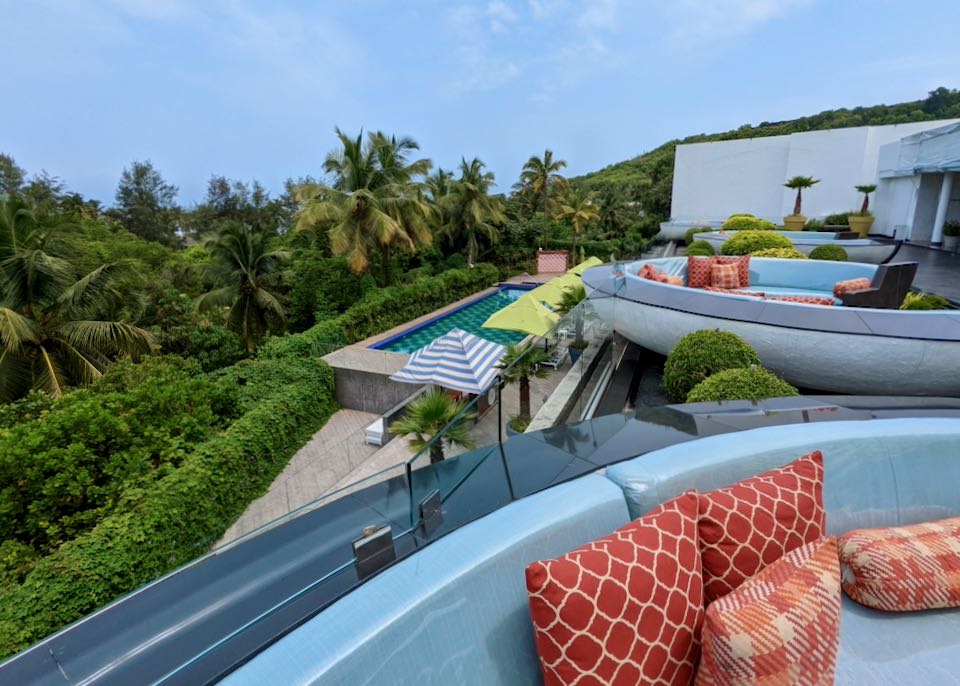
The W Goa is the best luxury hotel in Calangute and one of our favorite resorts in all of Goa.
- Best Luxury Hotels in Goa
W Goa • Alila Diwa • Radisson Blu • Diwa Club • Taj Fort Aguada • La Estoria • The Crown • Hard Rock Hotel • Holiday Inn Resort • Novotel Candolim • Novotel Dona Sylvia • Westin • Taj Cidade de Goa Horizon • St Regis- Best Boutique/Midrange Hotels in Goa
Fairfield Calangute • Sonesta Inns • Santana Beach Resort • Hilias Retreat • Art Resort Goa- Best Goa Hotels for Families
Taj Exotica Resort & Spa • ITC Grand • Karma Royal Haathi Mahal • Alila Diwa • Beleza By The Beach • Novotel Dona Sylvia Resort- Best Cheap Hotels in Goa
Alagoa Resort • Hospedaria Abrigo de Botelho • John’s Highland Comfort Guest HouseBest Area in Goa for…
- Best Towns in Goa for Beaches: Cavelossim and Mobor
It’s quite impossible to choose the finest because there are so many and visitors have different preferences depending on, for example, attractiveness, facilities, activities, and convenience. Cavelossim and nearby Mobor tick all the right boxes like many others: glorious beaches (and surprisingly uncrowded in places), tempting cafés on the sand, and stunning sunsets. Unlike others, however, these adjoining beaches are close-ish to the airport, accessible by local bus, and provide compact areas of modern facilities, including resorts virtually on the beach.- Best Area in Goa for Water Sports: Baga
A range of activities such as jet-skiing and parasailing are available at several beach areas, but the variety and standards are not like those found in Thailand or Bali. One popular and convenient area that offers a better-than-average selection at not-too-overpriced rates is Baga, where more sedate banana-boat rides are also available. Elsewhere across the state, enthusiasts may also enjoy kayaking in the various rivers, surfing at Ashwem and Arambol, kite-surfing in Mandrem, and scuba-diving organized from agencies at Calangute and Baga. Note: No water sports will be available during the monsoon season (June to September) and, possibly, a month before and after.- Best Areas in Goa for other Outdoor Activities: Candolim and Calangute
As well as the range of water sports listed above, extensive activities are also offered in many areas: e.g. boat trips from the capital, Panaji, along Mandovi River (where crocodiles appear harmlessly), paragliding at Arambol, rafting down Mhadei River, guided walks through national parks and sanctuaries, rides on ATV quad bikes, and dolphin-spotting at Palolem. These are best organized through any of the numerous travel agencies in Candolim and Calangute, but most activities would not be available during the monsoon (June to September) and, possibly, a month before and after.- Best Area in Goa for Sightseeing: Panaji (Panjim)
Of course, the beaches are the overwhelming attraction, so few visitors venture more than a few hundred meters from the sea and shops. While a few forts can be found along the coastline, most of the actual sights – e.g. whitewashed churches, colonial-era gardens, and worthwhile museums – are in central Goa. The former capital, now called Old Goa, is dotted with remnants of Portuguese rule, but many are frustratingly neglected. More appealing is the old Latin Quarter of the current capital, Panaji, where river cruises can also be arranged and overnight stays in lovingly-renovated and centuries-old guesthouses can be booked.- Best Area in Goa for History: Old Goa
In the older part of Panaji, the current capital, many private and public buildings from colonial times have been beautifully renovated and painted brightly. Not so, unfortunately, in the former capital, now called Old Goa. Recognized by UNESCO for its heritage sites, the compact area of Old Goa is lined with ruins of churches, cathedrals, and forts, mostly abandoned and beyond repair, but it does feature two magnificent attractions: the Basilica de Bom Jesus and Sé Cathedral. The range of accommodation in Old Goa is poor, however, so make a day trip from Panaji, which is only 10km away and offers a number of adorable old guesthouses.- Best Area in Goa for Shopping: Baga
Goa’s capital, Panaji, offers boutiques in the older part and undersized malls in the suburbs, while every beach area is packed with stalls, though most souvenirs are tacky and overpriced. For a superior range and prices more slanted towards Indians than foreigners, visit the Arpora Saturday Night Bazaar between the beaches of Baga and Anjuna. More convenient to most visitors than similar markets elsewhere in Goa, this market offers 500 handicraft and food stalls each Saturday evening (but not during the monsoon, June to September). Things to look out for include jewelry, antique reproductions, spices used in the fiery Goan cuisine, items made from terracotta, and hand-painted tiles.
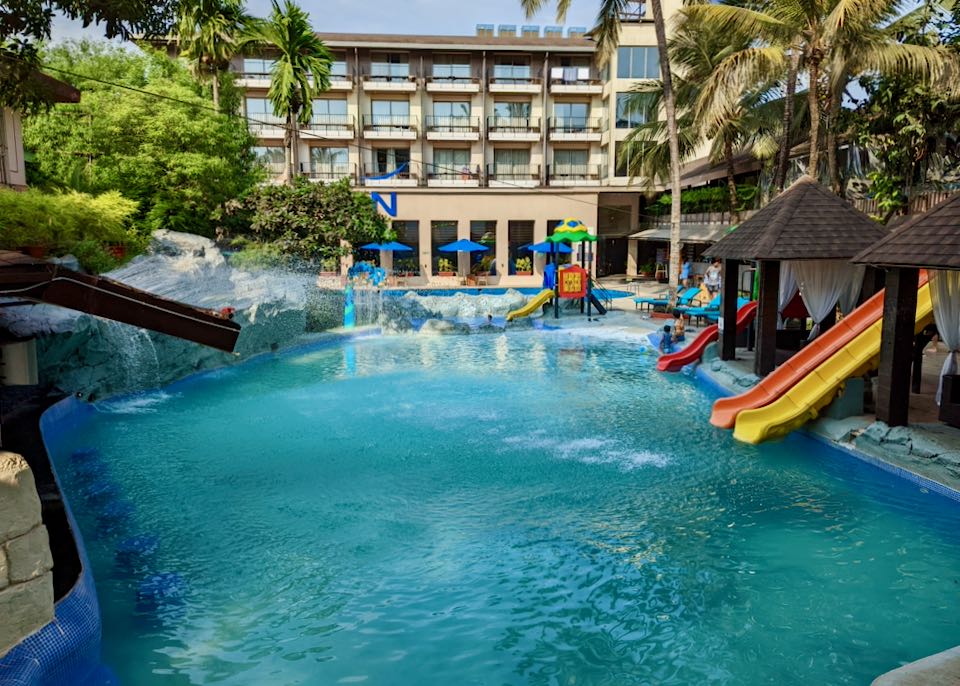
The Novotel Candolim is great for families and first time visitors.
- Best Area in Goa for Families: Cavelossim
With more than 15 tourist areas across Goa, it is hard to narrow down just one that’s ideal for families. Those traveling with children would, however, appreciate what Cavelossim can offer: less distance from the airport, fewer vehicles (and, therefore, less noise and pollution), proximity on foot to more than enough places to eat and shop, activities along the nearby river, a clean and surprisingly uncrowded beach, and a wide range of resorts, including several with facilities and activities for families. Also popular elsewhere across the state are Splashdown Water Park (north of Calangute), go-karting (near Baga), horse-back riding (at Majorda), the planetarium (in Panaji), and the range of water sports and other outdoor activities described earlier.- Best Area in Goa for Food & Restaurants: Vagator
Goan cuisine is heavily influenced by its Portuguese heritage and strongly inspired by Hindu and Muslim traditions from nearby states. Seafood is a specialty and visitors can enjoy mouth-watering local delicacies like xacuti (spicy chicken/lamb curry) and cafreal (marinated and grilled chicken). Also popular are the beef or prawn vindaloo, desserts like bebinca layered cake, and snacks such as sanna rice cakes. Every beach area offers fantastic places to eat, including numerous bamboo cafés on the sand, but uniquely positioned are those on the clifftops at Vagator and within sight of a crumbling fort.- Best Area in Goa for Transport: Calangute
The airport is in central Goa and not convenient to any beach area, or even the capital, Panaji. Three areas are conveniently linked by local bus, rare examples where foreign tourists are encouraged to use public transport anywhere in India: (1) along the main road through Candolim and Calangute and, sometimes, on to Panaji; (2) along the main road between Cavelossim and Mobor and to Margao; and (3) around the beaches of Majorda and Betalbatim and also on to Margao. In some places – particularly Calangute, the most developed beach region – it’s also possible to hire a car or motorbike. Goa is the only place in India where this is even remotely recommended for foreign tourists.- Best Area in Goa for Nightlife: Baga
Most beach areas offer some sort of nightlife – usually loud and oriented towards young people, especially at Anjuna and Vagator. More variety can be found in Calangute, from karaoke bars to live music venues, while in adjoining Candolim, an impressive array of jazz and blues bands play nightly. Just north of Calangute, Baga is renowned for its assortment of nightlife in a fairly compact area, especially along Tito’s Lane. Some places are tiny and others are huge all-in-one entertainment complexes, but there are problems around this area: drugs, drunks, sleazy patrons, possible sexual harassment, and potential petty crime. Some places close during the wet season, June to September.- Best Areas in Goa for Yoga & Spirituality: Anjuna, Vagator, & Palolem
For some, a major attraction is not the beach or sun, but yoga and meditation. Ad hoc and regular classes are offered at mostly modest – but also at a few chic – retreats that have been built in many places, especially the more remote areas of Arambol and Mandrem to the north and Agonda and Palolem in the south. All sorts of spiritual-related activities for the mind, body, and soul are offered, including Ayurveda massages and alternative therapies. Particularly impressive, and probably more convenient to most visitors, are the yoga retreats at Anjuna, Vagator, and Assagao, a little farther inland. Some places may close during the wet season, June to September.- Best Area in Goa for Festivals: Panaji (Panjim)
While some resorts and café/bars organize music festivals for younger visitors in beach areas like Vagator and Anjuna, most culturally-oriented events are held in the state capital, Panaji. This is because they’re often arranged by the government, which is based in the city. The capital is home to most of the state’s major venues. It is also where most locals live, and it’s centrally located for visitors. A range of festivals is held – mostly in the dry months of October to April – based around art, literature, and music (particularly jazz). Most intriguing is the traditional Goan dance and music performed in the local dialect.- Best Area in Goa for Vibe & Culture: Panaji (Panjim)
The relentless development of the beach areas has inevitably affected centuries-old fishing villages and larger inland towns, with new malls and resorts coming up among palm groves and churches, and trendy boutiques replacing old-fashioned shops. The only place in Goa with any traditional and colonial-era vibe is Panaji, irrefutably the most pleasant state capital in India. Nicely positioned alongside a major river, the old part (called the Latin Quarter or Fountainhas) is packed with centuries-old shops, cafés, and public buildings, many beautifully-renovated and brightly-painted. Frequent festivals, some focusing on Goan culture, add to the allure, which can be enhanced enormously by staying at one of the exquisite old guesthouses.
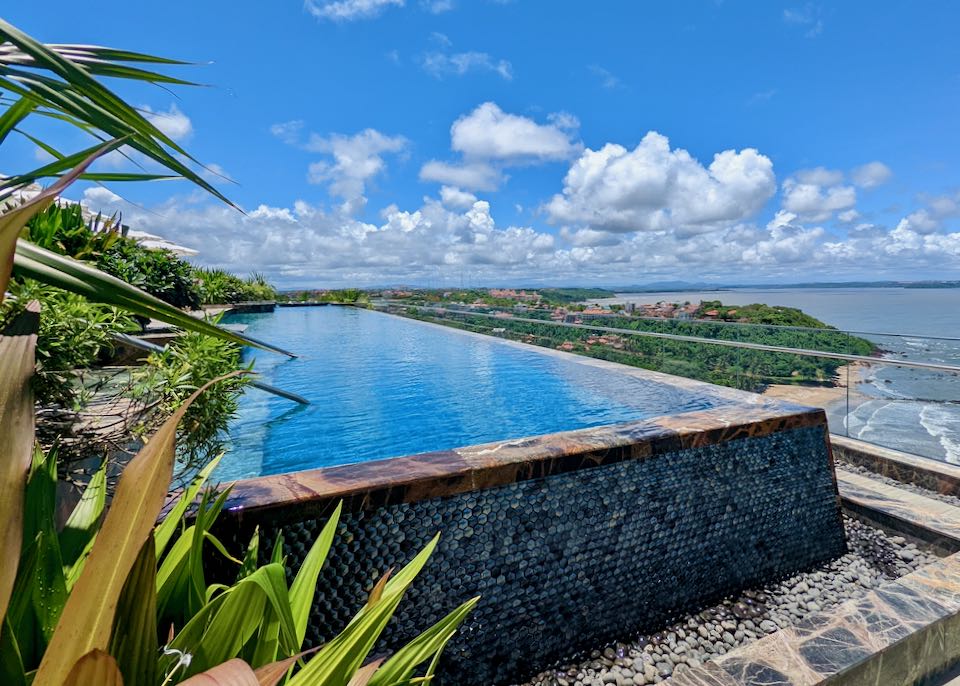
The brand new Taj Cidade de Goa Horizon overlooks Vainguinim Beach.
- Best Town for Couples in Goa: Cavelossim
Many tourists, particularly those from across India, come to Goa for a honeymoon or romantic getaway. Any of the 15 or so beach areas would be suitable, but some are quieter than others, while several offer more interesting activities than just sunbathing and drinking. A delightful and compact area of tourist facilities, Cavelossim is squeezed between a glorious beach (ideal for sunsets) and a broad river (great for boat trips) and is located along the main road (perfect for cycling). Some of the magnificent resorts here offer secluded villas featuring traditional designs and bright exteriors and are located as close to the beach as authorities allow.- Best Areas in Goa for First Time Visitors: Cavelossim and Mobor
The crowds, traffic, pollution, and poverty prevalent elsewhere in India are mostly absent in the beach areas – not so, however, among the more developed areas of central Goa. Those arriving for the first time may want to consider these factors: proximity to the airport, access to a wide range of tourist facilities within walking distance, links by various transport options, and choice of well-maintained hotels, including world-class resorts. With its clean and safe beaches midway along south Goa, Cavelossim and adjacent Mobor tick all the right boxes for first time travelers to Goa.- Safest Area in Goa: Majorda
The sort of potential dangers that exist in Indian cities, such as cough-inducing pollution and crazy traffic, are less problematic in Goa. Obviously, some dangers still exist, including those caused by drugs and alcohol, as well as sexual harassment and opportunistic petty crime. Take the usual precautions, which include swimming between flags and avoiding the sea completely during the monsoon. The nightlife at places like Baga can be sleazy and unsuitable for females traveling alone, while the inexperienced can get into trouble at places like Anjuna, where all-night rave parties are frequent. To avoid these issues, as well as the traffic and crime more common in more developed areas around Goa, travel in groups and try staying somewhere like Majorda, which is serene, family-oriented, and distant from the main road and village center.The 11 Best Cities & Beach Towns in Goa for Tourists
Staying in South Goa
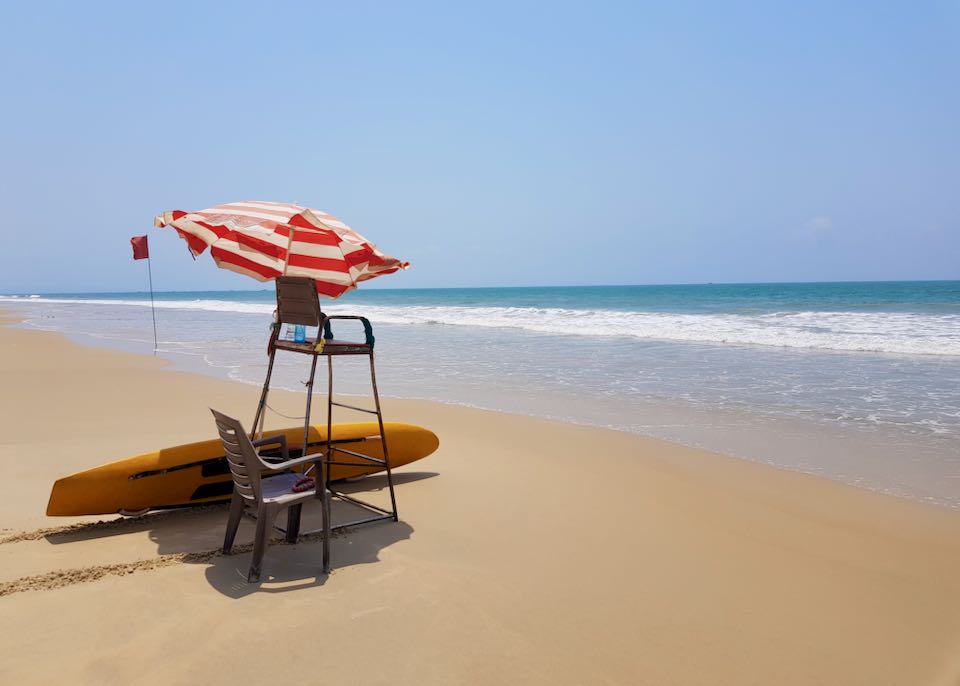
The stretch of sand from Benaulim to Cavelossim is the best beach in Goa. The St Regis and the Taj Exotica Resort & Spa are the two best beach resorts in this area.
1. Utorda, Majorda, Betalbatim – About 17-19km from the airport.
Among the closest to the airport, these three adjoining beaches are conveniently linked by local bus to each other and the regional hub of Margao. With flat paths lined by palm groves and away from the main road, this is a great area for cycling (and hotels often rent bikes). Among the few top-end resorts are some likable mid-range hotels and an agreeable but limited array of facilities, including the typical bamboo cafés on the sand. Sections of the beaches are surprisingly empty, while some areas are so undeveloped that the accommodations are among farms with buffaloes.
- Best Luxury Hotels: Alila Diwa • Diwa Club • ITC Grand
- Best Boutique/Midrange Hotel: Beleza By The Beach
- Best Cheap Hotels: John’s Highland Comfort Guest House • Alagoa Resort
2. Colva & Benaulim – About 21-23km from the airport
Popular since the Hippy Trail of the 1960s, the laidback feel and village vibe of Colva are gradually receding each year as it becomes more developed. Even though it is now dominated by mid-range resorts that offer plenty of space and gardens, Colva is not as crowded as Calangute or Baga because development is restricted by meandering roads. A little farther south are the quieter – and, sometimes, virtually empty – stretches of beach at Benaulim. Both areas also offer a limited range of water sports.
- Best Luxury Hotels: Beira Mar Beach Resort • Taj Exotica Resort & Spa
- Best Boutique/Midrange Hotels: Da Silva Guest House • Soul Vacation Resort & Spa
- Best Cheap Hotel: Vinsons Cottages
3. Cavelossim & Mobor – 34-36km from the airport
Midway along the southern coast, these adjoining beaches are sprinkled with top-end resorts, some offering adorable brightly-painted bungalows among vast gardens as close to the beach as possible. The main road through Cavelossim offers an excellent range of facilities and is a short stroll from the river (where boat trips are available). The dead-end road south to the almost Crusoe-esque beach at Mobor is flat and quiet, and thus, ideal for cycling. (Some hotels rent bikes.) A bonus is that the main road linking both areas is accessible via the reliable bus service.
- Best Luxury Hotels: St Regis • Novotel Dona Sylvia Resort • Radisson Blu • Holiday Inn Resort • Karma Royal Haathi Mahal
- Best Boutique/Midrange Hotel: Shikara Beach Resort
- Best Cheap Hotel: Sal Riviera
4. Margao – 26km from the airport
The regional capital of Margao (formerly known as Madgaon) is the only inland town worth staying in outside of the state capital, Panaji. There is no beach, obviously, but it does offer some charm, a few remnants of Portuguese rule, and more facilities than along most beaches. Most importantly, it’s a convenient transport hub for bus trips around Goa – including nearby beaches such as Majorda – and train travel all over India.
- Best Luxury Hotel: Nanutel Margao
- Best Boutique/Midrange Hotels: Goa Woodlands Hotel • Dudhsagar Plantation & Farmstay
- Best Cheap Hotel: City Comfort
5. Farther South – 54-61km from the airport
To escape the crowds and overpriced hotels, more travelers are heading south, down the coast. Cola/Khola is a classic beach: secluded, almost deserted, and barely developed because it’s not easy to reach. With a lagoon and forested backdrop, the setting is gorgeous. Agonda is also very relaxed even though it is more developed because the village street is close to the beach. Adding to the appeal is the backdrop of cliffs, surfing, and turtle nesting sites (so no water sports or loud music are permitted). The golden sands and angled palms make Palolem one of Goa’s most photogenic beach, especially at sunset. The calm waters that are ideal for kayaking and paddle boarding are also popular with families and long-stayers who enjoy yoga and meditation. The best hotels on Palolem Beach are Hilias Retreat and Art Resort Goa – both steps from some of the best sand in Goa. Even more relaxed, Patnem is appreciated by those who stay for months (or longer).
- Best Luxury Hotel: LaLiT Golf & Spa Resort
- Best Boutique/Midrange Hotels: Hilias Retreat • Art Resort Goa
- Best Cheap Hotel: Cinnamon
Staying in North Goa
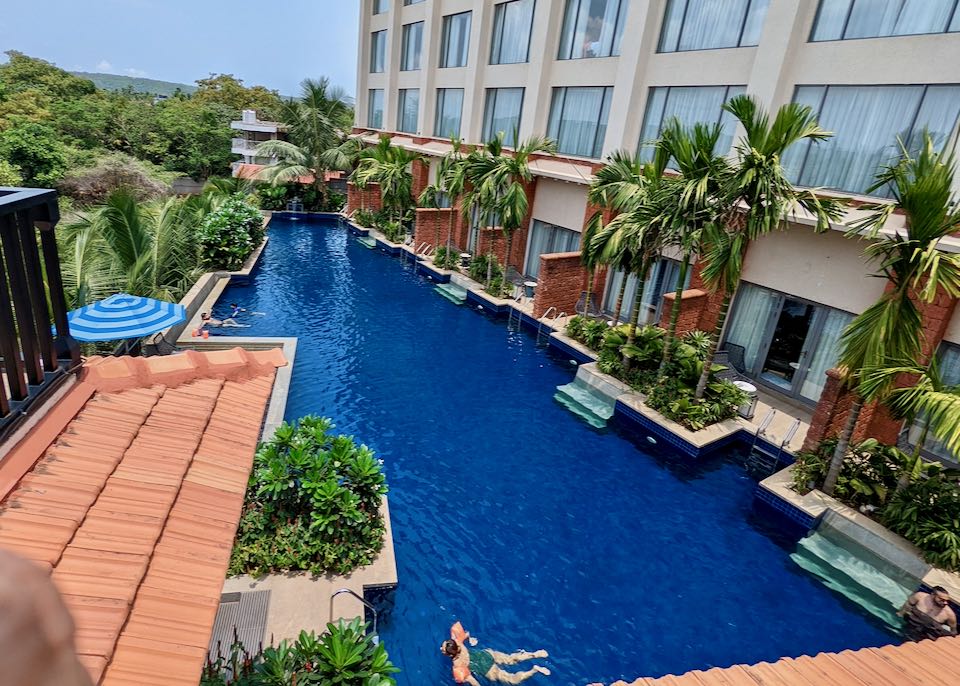
The Westin Goa in Anjuna.
6. Candolim & Calangute – 36-37km from the airport
The most accessible to the airport along the northern coast, these two developed regions are dominated by mid-range accommodations popular with packaged tourists from Europe, the UK, and, increasingly, Russia. The main road which stretches north from the mighty 17th-century Fort Aguada and parallels the beach is brimming with places to eat, drink, and shop, and linked by a reliable local bus service (which also connects the state capital, Panaji). Short lanes from the main road lead to glorious beaches lined with bamboo café/bars. The main beach farther north (not far from the Hard Rock hotel) is more Indian-style: i.e. very busy and noisy, and crammed with cafés, bars, and shops, so not relaxing.
- Best Luxury Hotels: Taj Fort Aguada • La Estoria • Novotel Candolim • Acron Candolim Regina • Hard Rock Hotel • Radisson Candolim • Taj Holiday Village Resort & Spa • Hyatt Centric
- Best Boutique/Midrange Hotels: Fairfield Calangute • Santana Beach Resort • Sonesta Inns
- Best Cheap Hotel: Mi Casa By The Sea
7. Baga Beach & Arpora – About 40km from the airport
The main road north of Calangute (see above) branches into different directions in Baga. The beach there is less appealing, often too busy for relaxing and sunbathing, and usually noisy with water sports. The area is renowned for its cheap accommodations, vibrant nightlife, and Saturday evening market. The main downside is that many hotels and facilities are spread along meandering lanes distant from the sea. Two main roads pass over Baga River (often more accurately called Baga Creek) to an area also called Arpora. Facing the river, or within a few minutes’ walk of it, hotels can significantly offer more space and tranquility than overcrowded Baga Beach, which is 1-2km away.
- Best Luxury Hotels: Fiesta Beach Resort • Colonia Santa Maria
- Best Boutique/Midrange Hotels: Tranquility Cottage Resort • Little India Beach Cottages
- Best Cheap Hotels: Waters Guest House • Mayflower Beach Resort
8. Anjuna & Vagator – About 44km from the airport
These adjoining beaches just over the river from Baga (see above) tend to be more popular with younger and more budget-conscious travelers. Becoming trendier over recent years, but still retaining a village vibe not common elsewhere, Anjuna comes alive during the Wednesday street market. The red cliffs, rugged coastline, and numerous coves make Vagator particularly scenic. It’s also a beach area of contrasts: refined dining on clifftop bistros, rave parties on the palm-fringed beach, and remnants of a Portuguese fort.
- Best Luxury Hotels: W Goa • Westin Goa
- Best Boutique/Midrange Hotel: Alcove Resort
- Best Cheap Hotels: Casa Vagator • Craft Hostels • Wonderland Hostel
9. Farther North – 51-58km from the airport
Stretching as far as the state border with Karnataka, Morjim, Ashwem, Mandrem, and Arambol are furthest from the airport and are thus quieter and less developed, which suits budget-conscious long-stayers, although in recent years, some mid-range hotels have been built to cater for Indian families. Alongside Chapora River and partially protected because of turtle conservation, Morjim is becoming increasingly developed. The area is popular with Russians who don’t seem to care about the grayish sand. The beach at Ashwem is particularly attractive and the lanes feature several yoga retreats and budget-priced accommodations. Of the four areas, Mandrem is the most appealing because it’s comparatively remote and undeveloped. Still primarily a fishing village, with bridges across a creek, it’s popular for its yoga/meditation hangouts. Without any resorts (yet), Arambol (also called Harmal) still retains a laidback feel as close to the 1960’s Hippy Trail as possible. Visitors also like to swim in the beautiful lagoon and try their hand at surfing and paragliding.
- Best Luxury Hotels: Acacia Morjim • Stone Wood Resort & Spa
- Best Boutique/Midrange Hotels: Treebo Trend Lands End Beach Resort • Rama Beach Resort
Staying in Central Goa
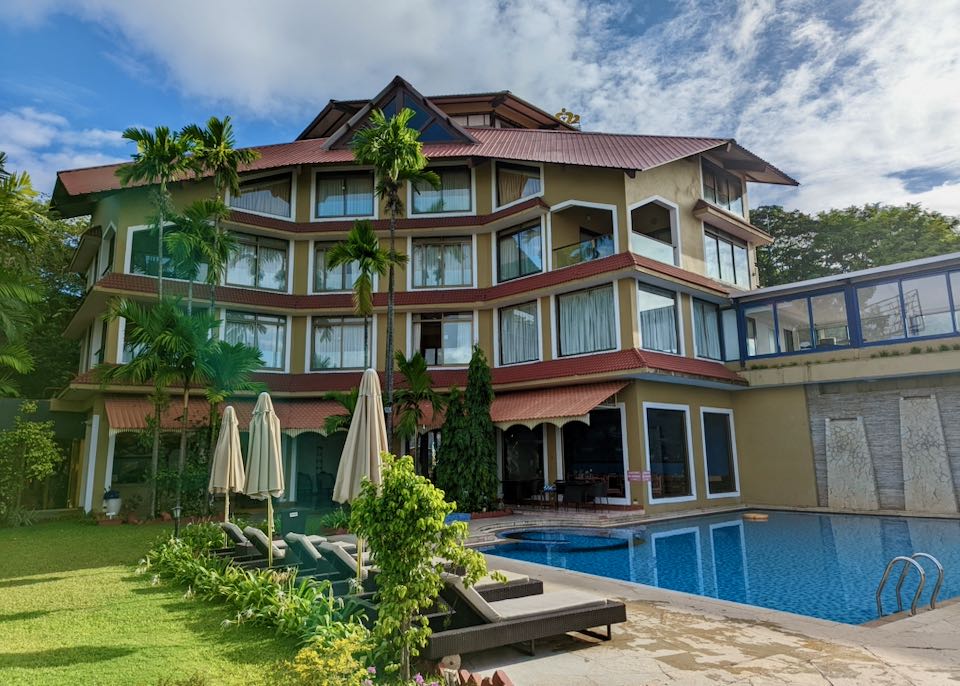
The The Crown hotel in Panaji, Goa.
10. Panaji (Panjim)
Still known by its former name (Panjim), the state capital of Panaji is pleasantly situated alongside a broad river (ideal for boat trips) and boasts a modest beach in the southwestern suburbs. The streets are far less crowded with people or traffic than any other state capital in India, but the attraction unquestionably is the older part of the city. The narrow lanes are crowded with colonial-era buildings, many beautifully-restored and brightly-painted, including centuries-old guesthouses, old-fashioned shops, riverside cafés, and whitewashed churches. Adding to the appeal are the state’s major bus station for services across Goa and beyond, chance to stay in a gorgeous old-fashioned guesthouse, and proximity to Old Goa (see below).
- Best Luxury Hotels: The Crown • Vivanta • Taj Cidade de Goa Horizon
- Best Boutique/Midrange Hotels: Mateus Boutique Hotel • Panjim Inn • Panjim Pousada
- Best Cheap Hotels: Hospedaria Abrigo de Botelho • Marquito’s Guest House
11. Old Goa
Not to be confused with the old section of the state capital, Panaji (see above), Old Goa (about 10km away) is the official name for the former Goan capital, now a UNESCO World Heritage Site. Most of the 30,000 inhabitants fled centuries ago during a malaria outbreak and the remaining abandoned the city when the river silted up, so the colonial-era capital was moved in the mid-19th century to Panaji. The compact area of Old Goa is lined with ruins beyond repair of churches, cathedrals, and forts, and is also home to the fantastic Basilica de Bom Jesus and Sé Cathedral. The range of accommodations is poor, however, but Old Goa is an easy day trip from Panaji, which offers several lovely old-fashioned guesthouses.
- Best Luxury Hotels: The Postcard Velha • The Fern Kadamba Hotel & Spa
- Best Boutique/Midrange Hotel: Cozywoods Hill Resort
- Best Cheap Hotels: Hotel Swarnam • Old Goa Residency
Read More
- Best Hotels in Agra
- Where to Stay in Agra
- Best Hotels in Bengaluru
- Where to Stay in Bengaluru
- Best Hotels in Chennai
- Where to Stay in Chennai
- Best Hotels in Delhi
- Where to Stay in Delhi
- Best Hotels in Jaipur
- Where to Stay in Jaipur
- Best Hotels in Jodhpur
- Where to Stay in Jodhpur
- Best Hotels in Kolkata
- Where to Stay in Kolkata
- Best Hotels in Mumbai
- Where to Stay in Mumbai
About Santorini Dave